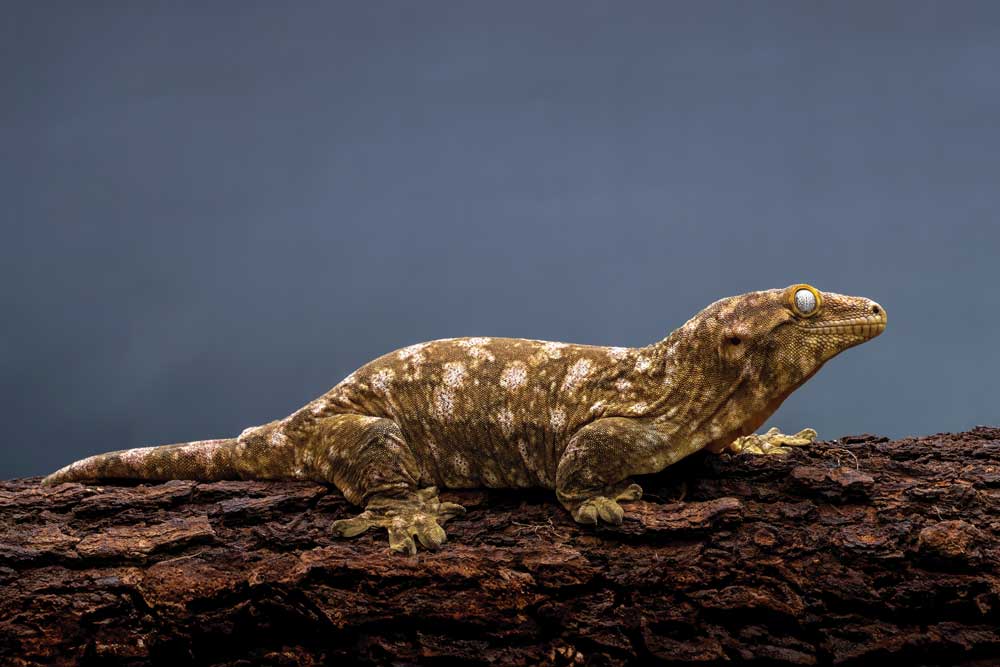Giant geckos, Rhacodactylus leachianus, are the largest extant species of gecko in the world. Hailing from New Caledonia, giant geckos are well known
Giant geckos, Rhacodactylus leachianus, are the largest extant species of gecko in the world. Hailing from New Caledonia, giant geckos are well known to nearly every hobbyist with some experience. New Caledonia was put on the map in the collective minds of gecko enthusiasts around the world beginning in the early 1990s, when the popularity of crested geckos (Correlophus ciliatus) began to take hold. In addition, other native species soon gained in popularity including gargoyle geckos (Rhachodactylus auriculatus), Chahoua geckos (Rhacodactylus chahoua), various Eurydactylodes, as well as a few other less commonly kept species.
How To Build A Bioactive Enclosure For Your Crested Gecko
8 Of The Most Popular Geckos For Reptile Keepers
Unlike gargoyle and crested geckos, “leachies” as they are popularly referred to, are not as common in private collections. The reasons for this general absence will be explained later in this article. Much has been written about the care and maintenance of this species over the years. The author is presenting his account based on 15 years of keeping and breeding this species. There are other methods to utilize. What is presented here is what has worked well for the author.
Classification
Giant geckos belong to the Genus Rhacodactylus, Family Diplodactylidae. As previously mentioned, other popular species in this genus include gargoyle geckos (R. auriculatus), Chahoua geckos (R. chahoua) and rough-snouted geckos (R. trachyrhynchus). Formally considered Rhacodactylus, the popular crested gecko is now considered to be Correlophus ciliatus.
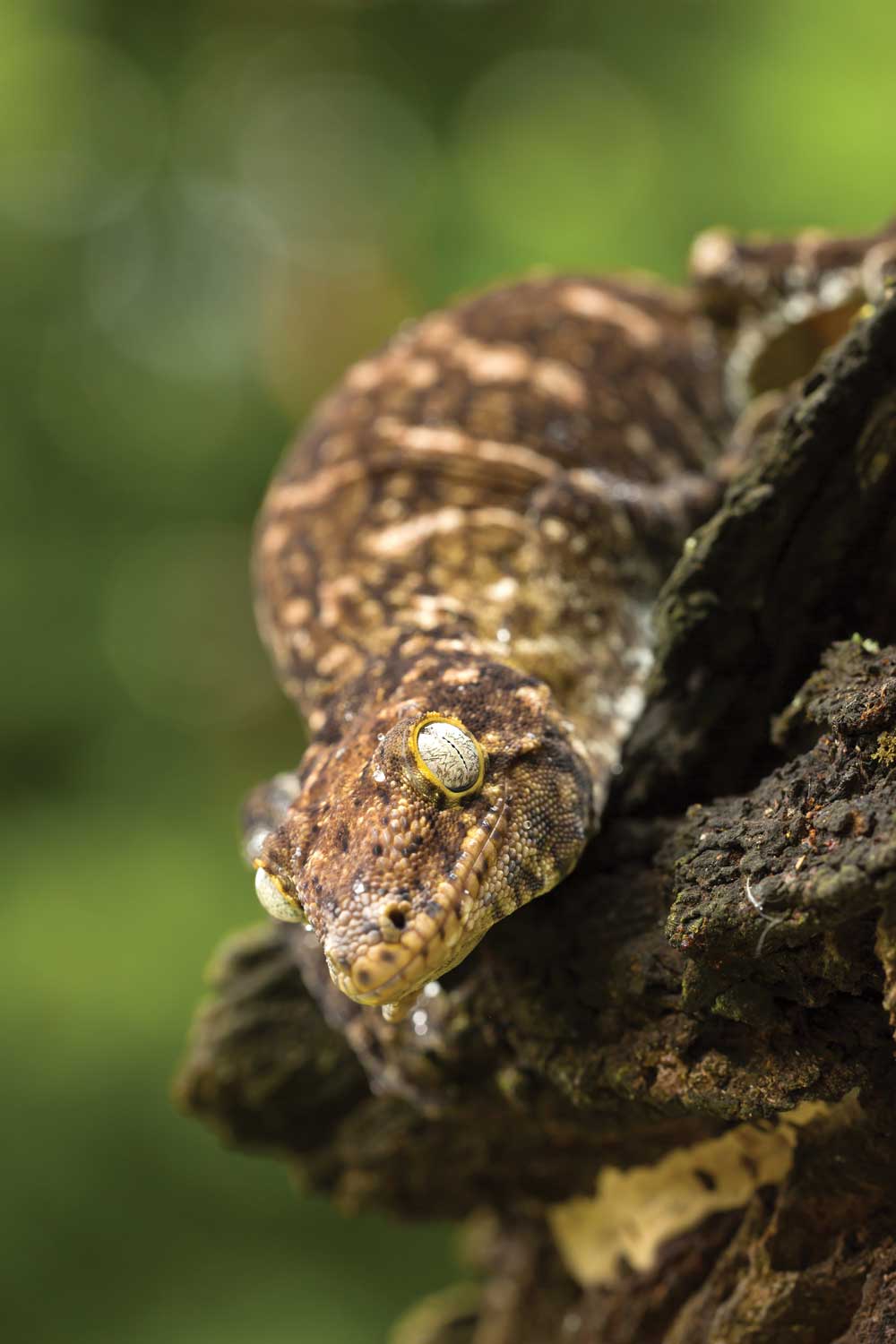
Unlike gargoyle and crested geckos, “leachies” as they are popularly referred to, are not as common in private collections. Photo by Milan Zygmunt/Shutterstock
Description
As previously mentioned, R. leachianus is the largest living gecko species. This designation is given with overall girth taken into consideration. The popular tokay gecko (Gekko gecko) is a runner up, with exceptionally large individuals reported at 49 cm (16 inches). A powerful build, large heads, and short tails exemplify R. leachianus, giving the species more overall bulk. Large adults can weigh up to 500 grams, with reports of some individuals growing to lengths in excess of 20 inches (50.8 cm). There are morphological differences based on the island of origin. Individuals of Grand Terre origin are regarded as the largest of the group while what is referred to as the insular island animals tend to be somewhat smaller but frequently more colorful. Individuals may vary but the island forms are frequently moss green with shades of pink, white, and tan depending on locale. Individuals from the Mt. Khogis region are referred to as the dark form.
Range
New Caledonia is an island nation east of Australia. It is comprised of the Mainland, Grande Terre, as well as a number of insular, or off-shore islands.
Habitat/Climate
R. leachianus inhabit forests spending their days hidden inside the cavities of tree trunks. At night the geckos will emerge to hunt for food. Grand Terre and the surrounding islands experience average temperatures ranging from 53 degrees Fahrenheit (11.6 degrees Celsius) to 93 degrees Fahrenheit (33.8 degrees Celsius) during the course of a year. So, while there is an absence of searing desert heat as well as deep winter freezes, the native fauna are used to warm days. Even though many gecko species from New Caledonia will do well at average room temperatures, it is important to keep the native temperatures in mind when housing leachies.
History in the Hobby and Availability
In 1992 Philippe DeVosjoli, Alan Repashy, and Frank Fast traveled to New Caledonia and were able to spend time observing various Rhacodactylus species in the wild. Individuals were collected and these animals served as the founder stock for many of the geckos available in the US today. Leachies have been in the US hobby for nearly as long as the aforementioned related species. Giant geckos certainly have their following but are not as popular as crested geckos, due in large part to the factors listed below. R. leachianus are more available now compared to previous years, however with this said, giant geckos are still not a common site in most pet stores. A fair number are available through online classified postings, and this is a good option for those unable to attend a reptile expo in person. Reptile shows are perhaps the best method for locating a leachie. Those who breed giant geckos and other less common species frequently have tables at most of the larger events such as the National Reptile Breeders Expo in Daytona, Florida and the NRBAC shows in select locations across the country.
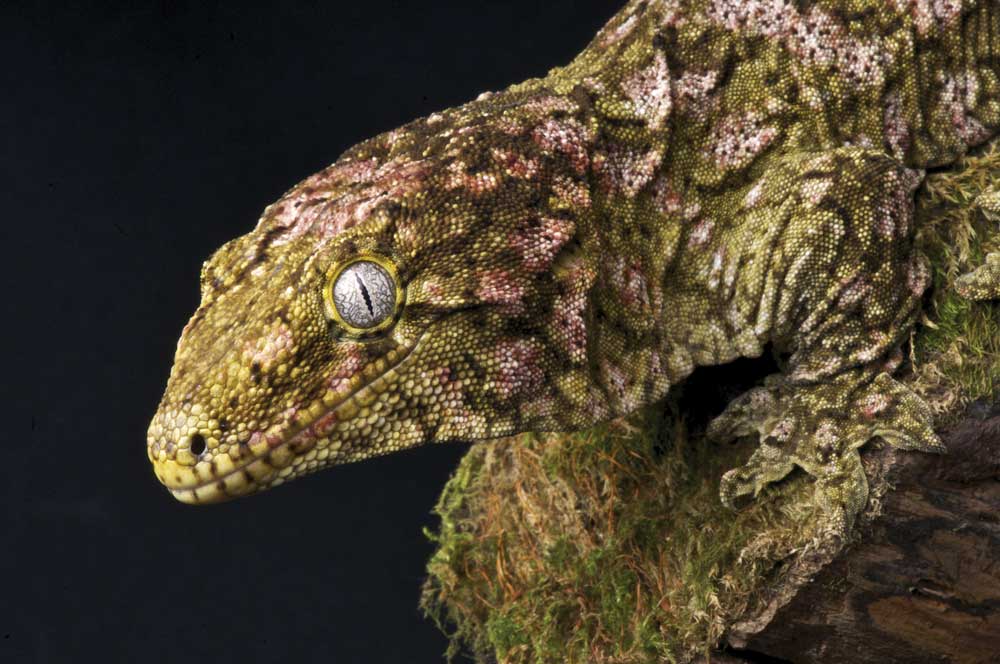
New Caledonian giant geckos are the largest gecko species in the world. Photo by Reptiles4all/Shutterstock
Ethno Herpetology
There is not a lot of readily available information on giant geckos and how the species is integrated into the culture of the indigenous people. In 2017 Dāv Kaufman traveled to New Caledonia with a film crew and recorded footage of R. leachianus and other species in the wild. According to Kaufman, one local Kanak legend involves the belief that the toepad hooks have the ability to rip the soul out of one’s body. As interesting as this lore is it can safely be stated that R. leachianus is overall a quite benign species in captivity.
Lifespan
How long a R. leachianus can live seems to be a matter of opinion. Estimates range from over 30 to up to 50 years. Given the large size and the fact that leachies originate from a slightly cooler environment compared to many tropical reptiles, it stands to reason that a long lifespan is not uncommon.
Housing
Leachies are large lizards and should be given large enclosures. If one is not prepared to provide sizeable housing, then perhaps one of the smaller relatives should be considered. The author currently maintains an adult pair in an enclosure measuring 48 inches (122 cm) long x 18 inches (45.7 cm) wide x 30 inches (76.2 cm) tall. Some suggest separate housing, only putting a pair together for breeding purposes.
Enclosure
R. leachianus are large, heavy bodied geckos and thus require substantial hides as well as climbing perches. Living in tree hollows in the wild, hides are provided in the form of wooden nest boxes designed for parrots. One is vacant and serves as the dry hide. It is in this one that the leachies spend most of their time during the daylight hours. The other contains a plastic pot filled halfway up with an organic topsoil and coir mixture which is kept moist but not damp. This box serves as a humidity shelter as well as a place for the female to deposit her eggs.
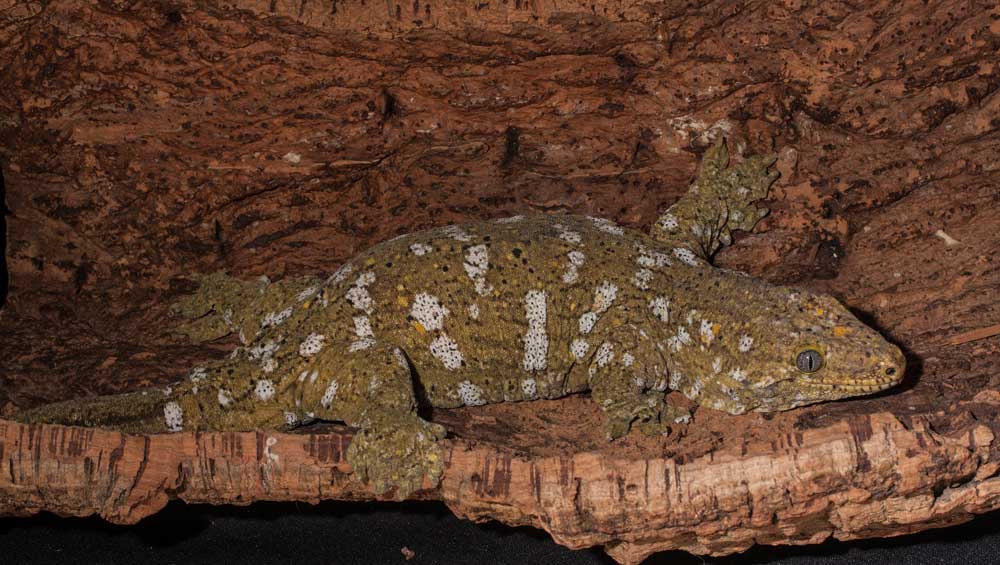
Ensure that your enclosure is large enough to hold a log in which your leach can hide. Photo by KHanley CHDPhoto/Shutterstock
Large sections of heavy driftwood provide additional climbing support. Care is taken to ensure that the driftwood is stabilized so that shifts in position cannot occur, which could potentially harm the lizards. Many keepers utilize large sections of cork rounds which make an attractive and versatile option for providing cover.
R. leachianus enclosures require frequent cleaning. The diet consists primarily of fruit and nectar-based foods, so the feces are frequently very messy. Unlike many Eublepharid geckos which will frequently designate one area of their enclosure as lavatory, leachies will defecate throughout their vivarium, including on all four sides of the glass. Due to this tendency the author opted for a more utilitarian cage design for ease of maintenance.
There are those who keep adults in more naturalistic enclosures complete with live plants and bioactive substrate. If plants are desired, then only durable species such as Sanseveria and other tough leaved species capable of withstanding the weight of the geckos should be used. While such a design certainly has advantages, such as being more aesthetically pleasing to the eye, any keeper who decides to go this route must be prepared to allow extra time for cleaning and maintenance. Adult leachies are messy and will make short work of a naturalistic display if meticulous attention is not adhered to. Young can be kept in more naturalistic setups if one desires, using vivarium soil, living plants, hardscape and so forth.
Substrate
There are keepers who also utilize substrate in adult enclosures. The author experimented with substrate in the adults’ enclosure years ago. Ultimately it was decided that due to the messy bowel habits of the geckos, a newspaper substrate is the easiest to maintain. This decision is in stark contrast to most of the rest of the author’s enclosures, where naturalistic substrates and living plants are utilized.
Temperature and Lighting
The author maintains his Leachianus at room temperatures that average 74 degrees Fahrenheit (23 degrees Celsius), with a several degrees increase in summer and similar decrease in winter. In the author’s experience giant geckos do well within these temperature fluctuations and no additional heat source has ever been used. Many keepers and breeders do recommend utilizing some form of heat in order to provide the lizards with access to higher temperatures and this is certainly an option worth consideration, especially if the given household tends to stay cool. The author’s leachie enclosure is kept in a room that receives plenty of natural light in addition to multiple lights from other enclosures. Since live plants are not included in the enclosure design, no additional lighting is utilized.
Diet
R. leachianus are omnivorous in nature. The natural diet consists of figs and other fruit, invertebrates, other reptiles, and even small mammals and birds. There are a number of commercially available diets designed specifically for leachies, crested geckos, as well as other nectar and fruit feeding geckos. The author feeds his leachianus a somewhat varied diet consisting of various commercial mixes and to a much lesser degree certain baby foods and feeder insects. Fresh fruit such as mango can be added to commercial mixes in order to add variety. Feeder insects should be gut-loaded prior to being offered. Some keepers will offer an occasional pinkie mouse.
The author’s feeding schedule is as follows:
- Monday: All individuals are fed a prepared food in the evening.
- Wednesday: The food bowls are removed. In the evenings hatchlings and younger individuals are again offered a prepared diet. The author makes a conscious attempt to ensure that a different food item is offered. The adults and older individuals are offered several insects such as large crickets (Acheta domesticus), superworms (Zophobas morio), dubia roaches (Blaptica dubia), and so forth.
- Friday: The bowls are again removed in the morning. Friday evenings all individuals are fed a prepared diet.
- Sunday: The bowls are removed.
In the author’s experience crickets and other insects are generally not accepted until around 6 months of age. Some exceptions have occurred, and conversely other individuals continue to refuse insects until well past the six-month mark.
Water
Giant geckos will readily drink from a water bowl. A sturdy water dish should be used. Larger clay saucers, with a waterproof base, designed for houseplants work well.
It is important to monitor for soiling by feces, otherwise the author changes the water every other day.
Can You Hold R. leachianus Geckos?
While it is fun to pick them up, there is no indication that the geckos enjoy long periods of handling. Individual temperaments may vary, in general however most are calm and will tolerate short periods of gentle interaction. When distressed, individuals will frequently make a chirping sound, so this is a good indication to return the gecko to the enclosure. R. leachianus can bite however and the powerful jaws and teeth can easily lacerate the skin.
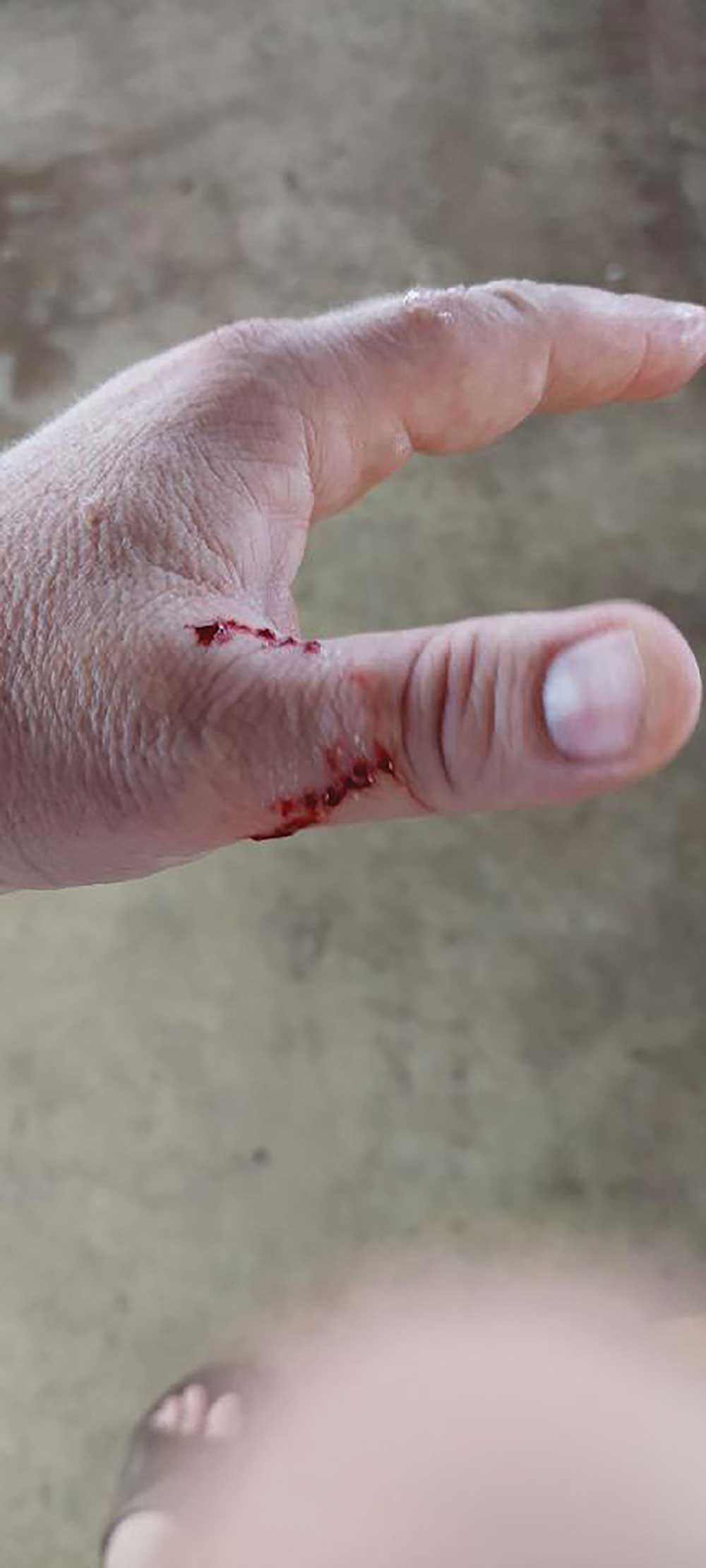
While rare, bites from giant geckos can be painful and cause localized bleeding. Photo by Nathan Manwaring
Factors That Affect Price
As previously mentioned, despite maintaining a presence in the hobby for decades, giant geckos remain expensive, especially when compared to less fancy morphs of crested and gargoyle geckos. One factor affecting the high price is compatibility. Pairs will remain compatible for many years, however this relationship does not always translate over to years of uninterrupted egg production. Individuals that seemingly get along for years may suddenly become incompatible and will need to be separated. Compatibility issues aside, females on average only lay approximately three clutches of two eggs each in a typical breeding season. The eggs take an extended period of time to hatch, depending on temperature, and the resulting offspring will not be sexually mature for at least three years.
Breeding R. leachianus Geckos
Adult males are identified by the presence of the hemipenile bulge and perianal pores. Juveniles can be sexed with less accuracy using a magnifying lens. One factor that makes sexing juveniles more difficult is the perianal pores develop on different timelines depending on the original island or islands of origin. It is recommended that offshore-island morphs be at least 120 grams before breeding is attempted, with 180 grams being the minimum size for mainland geckos. The author’s animals generally start breeding in mid to late spring and continue through the summer months. Gravid females may refuse food just prior to laying but display ravenous appetites afterwards. Additional calcium is provided during this time. During mating males will bite females around the neck area. Some minor scarring is not unusual. If significant damage to the female is noticed then the pair should be separated.
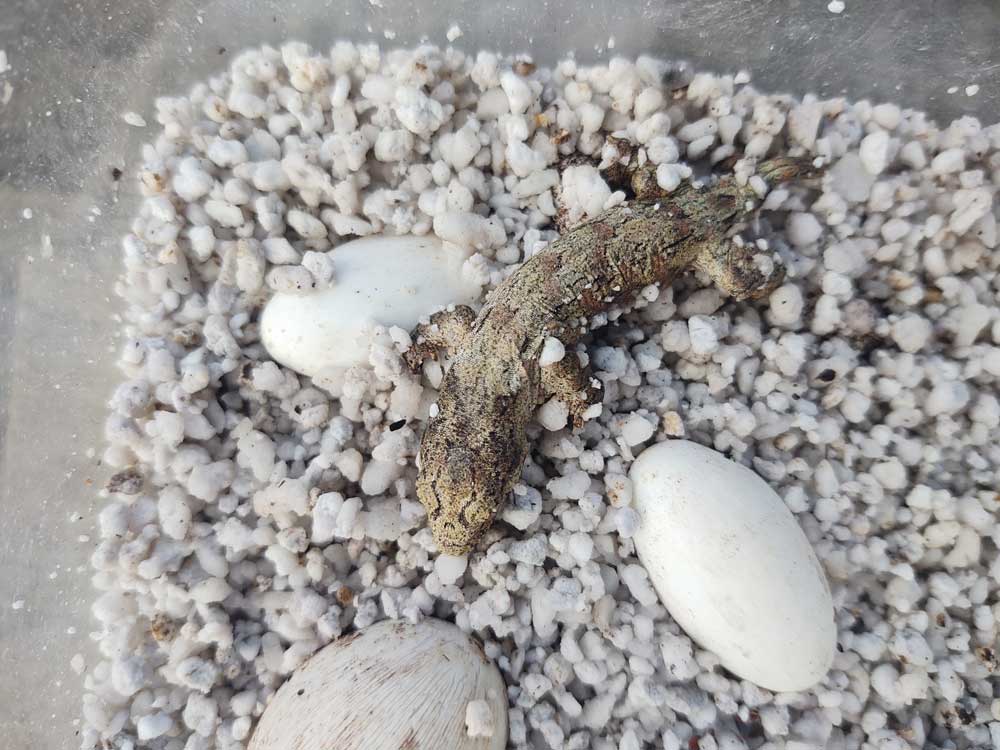
R. leachianus soon after hatching. Photo by Ashley Reves
Eggs are laid in clutches of two with the typical annual yield being around three clutches a year. In years past there were times when four clutches were laid, however not all eggs were fertile.
Dāv Kaufman has video footage of a wild leachie male that appeared to be guarding a clutch of eggs. Compared to video documentation of so many other reptile species, R. leachianus has rarely been filmed in the natural environment. Additional research will be needed to confirm or deny any parental care by the males however the footage recorded by Kaufman is compelling.
Incubating R. leachianus eggs
Incubation is straightforward. The eggs are placed in smaller sized plastic enclosures marketed for baby reptiles, amphibians, and invertebrates. There are several commercial brand hatching media available on the market. The author tends to rotate these with standard perlite which can be purchased at any home and garden store. The media should be moist but not soaking wet. It is important to check the media daily in order to prevent it from drying out. An additional method of incubation involves using commercial plastic trays designed specifically for incubating reptile eggs. The trays are placed in deli cups which are partially filled with water. The cups are then placed in the incubator. Incubation time for R. leachianus eggs can average from around 45 to 150 days, depending on temperature. Standard recommended incubation temperatures range from 72 degrees Fahrenheit (22.2 degrees Celsius) to 84 degrees Fahrenheit (28.8 degrees Celsius). The author’s incubation containers are kept in the same room as the parents and incubation times average around 90 days.
Raising Young R. leachianus
Upon hatching, R. leachianus tend to be tan in coloration but otherwise look like miniature versions of the adults. The author raises hatchlings separately in order to give more focused attention to each individual and to better monitor growth. Growth rate in general is dependent on the island of origin but is slow when compared to many other species of lizards.
Hatchlings are reared in plastic enclosures with snap on lids specifically designed for reptiles, amphibians, and invertebrates. Sterilite tubs with snap on lids are used as the animals grow in size. It is important to drill plenty of ventilation holes both in the lid as well as around the upper sides in order to provide cross ventilation. Paper towels are utilized as a substrate and crumpled up sections of packing paper works well as both a shelter and climbing perch. Both materials are easily replaced when soiled. Water is provided in a small plastic lid such as the ones used on fish food containers. Giant geckos can take three to five years to reach breeding size.
Conclusion
R. leachianus is a hardy species for those prepared to meet the spacing requirements. The ease of care and feeding make these incredible geckos wonderful captives that will live for many years under proper conditions.
Foster Reves is a freelance writer and Registered Nurse. Foster has been keeping and breeding various reptiles, amphibians, fish, and invertebrates for more than 50 years. Residing in SW Virginia, Foster lives with his wife, two children, and an assortment of other animals.
References: https://youtu.be/0FJNE4V7aPI

